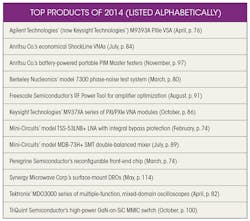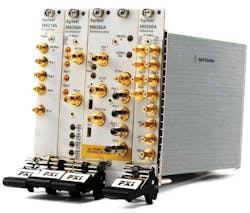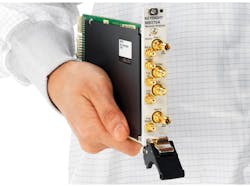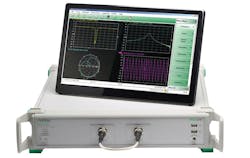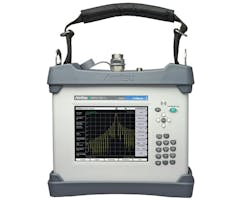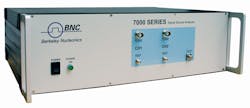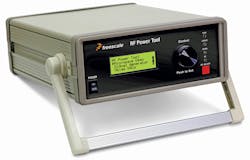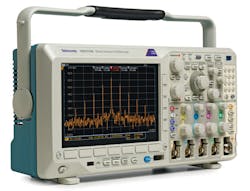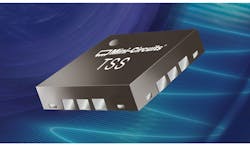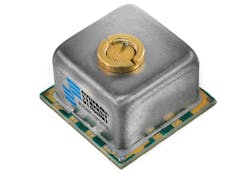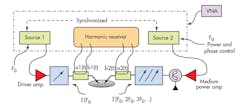Top Products of 2014
This file type includes high resolution graphics and schematics when applicable.
Any list that attempts to highlight the “top” products for a particular market during a calendar year will be somewhat arbitrary and a cause for debate, since engineers will show interest in different products depending on their needs. But some types of products that are required fairly regularly, such as building-block components and test equipment, can usually be found on the Microwaves & RF Top Products of the Year list for a given year, and the same is true for 2014.
It has been a year of solid RF/microwave engineering and technical advances as the industry continues to find practical ways to generate, send, and receive electromagnetic (EM) energy across wider bandwidths and at higher frequencies.
Many of the products known to users as Agilent Technologies’ test instruments, such as spectrum analyzers and vector network analyzers (VNAs), would become Keysight Technologies’ products. For example, the M9393A VSAs introduced earlier in the year as Agilent Technologies’ products are now Keysight Technologies’ products. The full Top Products of 2014 list is shown in the accompanying table.
The M9393A PXIe VSA (Fig. 1) allows users to assemble test systems with different modules, for a measurement range of 9 kHz to 27 GHz with the most broadband modules—or test bandwidths of 9 kHz to 8.4 GHz, 9 kHz to 14.0 GHz, and 9 kHz to 18.0 GHz with other modules. For a model M9393A VSA, PXIe modules fill five slots in a PXIe chassis and include a frequency downconverter, a frequency reference, a digitizer/intermediate-frequency (IF) processor, and a microwave frequency synthesizer.
When used with the firm’s model M9037A PXIe embedded controller, which is essentially a personal computer (PC) in PXIe format, the VSA can achieve its top signal switching speed of 150 μs. The VSAs offer many options in terms of analysis bandwidths and memory storage. The standard analysis bandwidth is 40 MHz, with options for 100 and 160 MHz. The standard instrument memory is 128 Msamples, with options for 512 and 1024 Msamples of memory.
Operating with its new name, Keysight also appears on the Top 2014 Products list for its M937XA series of PXI/PXIe VNA modules for applications as wide in bandwidth as 300 kHz to 26.5 GHz (Fig. 2). Each PXI/PXIe module packs two high-density printed circuit boards (PCBs) and two ports of microwave VNA measurement capability, making it possible to fill a PXI/PXIe chassis with as many as 16 measurement modules and 32 fully synchronized VNA measurement ports.
Examples of the bandwidths covered by these modules include 300 kHz to 4.0 GHz in the model M9370A, 300 kHz to 9.0 GHz in the model M9372A, and 300 kHz to 26.5 GHz in the model M9375A module. For ease of use, the VNA modules work with the same proven user interface and standard commands for programmable instruments (SCPI) programming commands as the benchtop PNA series of RF/microwave VNAs introduced earlier by Agilent (and now supported by Keysight).
A somewhat older name in RF/microwave test-and-measurement technology, Anritsu Co., landed several products on the Top Products list for 2014, including its ShockLine Series of VNAs for users on tight budgets. Available in two- and four-port versions with frequency coverage as wide as 1 MHz to 40 GHz in two-port systems and as wide as 50 kHz to 8.5 GHz in four-port systems, these VNAs are simple to use and simple in format, with manual operation possible by connection to a touchscreen (Fig. 3). They are well suited for performing full S-parameter measurements on passive components, with two-port dynamic range of better than 110 dB and corrected directivity of better than 42 dB.
The low-cost instruments deliver accurate results with fast measurement speeds, operating at sweep speeds as fast as 70 μs/point thanks to patented VNA-on-chip technology. The compact VNAs can fit into 2U-high chassis and can use a connection to a local-area-network (LAN) interface for remote control. Each of these low-cost VNAs is shipped with a standard three-year warranty, even at a US price tag starting at just under $13,000.
The firm also earned Top Products recognition for its MW82119B passive-intermodulation (PIM) Master line of portable testers for measurements from 2 MHz to 3 GHz. These analyzers can run on battery power and still deliver the 40-W test-signal tones needed to produce PIM in the field. These portable units (Fig. 4) combine the high-power test-signal generators with the capabilities of the firm’s popular Site Master cable and antenna analyzers, enabling contractors and service providers to meet many of their in-field RF/microwave communications system measurement needs without hauling multiple test instruments.
The PIM Master testers can be specified for popular wireless bands, such as the 900 MHz E-GSM band, the 1800-MHz DCS band, the 1900/2100-MHz AWS band, the 2100-MHz UMTS band, and the 2600 MHz LTE band. They also simplify measurements in remote locations, such as for Remote Radio Head (RRH) installations or indoor Distributed Antenna Systems (DAS).
Each PIM Master measures just 13.8 × 12.4 × 6.0 in. (350 × 314 × 152 mm) and weighs between 20 and 27 lbs (9.0 to 12.2 kg). Each runs on a rechargeable lithium-ion battery with about three hours run time per charge. They feature 8.4-in (213-mm) diagonal color touchscreen displays with 800 × 600 pixel resolution. Screen settings can be adjusted for cloudy conditions and night-time use. To help with the first time in the field, line sweep tools (LST) software for managing test results and one-day training course are available for learning more about PIM measurements.
Another important high-frequency measurement addressed by a new test product in 2014 was phase noise, and the model 7300 phase-noise test system from Berkeley Nucleonics provides a variety of noise and other measurements on carriers from 5 MHz to 26.5 GHz. The compact, single-box solution (Fig. 5) can evaluate phase-noise levels at frequency offsets from 0.1 Hz to 1 MHz.
The tester includes an internal frequency reference source but can also be used with external frequency reference sources from 5 MHz to 6 GHz and power levels from +8 to +18 dBm. It can work with internal frequency references from 2 MHz to 26 GHz. The instrument exhibits residual phase-noise floor of -140 dBc/Hz offset 1 Hz from the carrier, -150 dBc/Hz offset 10 Hz from the carrier, -160 dBc/Hz offset 100 Hz from the carrier, -175 dBc/Hz offset 1 kHz from the carrier, and -180 dBc/Hz offset 10 kHz and more from the carrier.
A firm usually associated more with active devices than measurements, Freescale Semiconductor, made a real contribution to developers of RF power amplifiers with their RF Power Tool. The compact instrument (Fig. 6)—which works with one of the company’s evaluation boards, a power supply, and a dummy load—can make all the key pulsed and CW amplifier measurements from 1 to 2500 MHz (with 1-Hz resolution), including gain, efficiency, bandwidth, VSWR, and bias requirements.
In support of the tester, the company offers evaluation boards for amplifier power levels from 50 W to 125 kW; these boards include sensors and other connectors that work with the RF Power Tool to complete the measurements. The RF Power Tool is connected to a PC and can work with software on the computer, including LabVIEW test software from National Instruments.
In terms of measurement power for the dollar, few can match Tektronix during 2014 with the introduction of its MDO3000 series of mixed-domain oscilloscopes (MDOs). Designed almost like a test laboratory with a handle, each MDO3000 instrument contains an oscilloscope, spectrum analyzer, logic analyzer, protocol analyzer, arbitrary function generator, and digital voltmeter (Fig. 7).
The oscilloscopes can be equipped with two or four measurement channels and measurement bandwidths from 100 MHz to 1 GHz while the spectrum analyzers can display test signals as high as 3 GHz. The oscilloscopes include a great variety of trigger functions and, for those in need of test signal flexibility, the optional arbitrary function generator can work at output rates to 250 MSamples/s to generate sine waves to 50 MHz and pulsed signals to 25 MHz. For added flexibility, a built-in waveform editor and integrated software provide 13 predefined waveform functions.
This file type includes high resolution graphics and schematics when applicable.
Creating Components
This file type includes high resolution graphics and schematics when applicable.
For users of low-noise amplifiers (LNAs), one of the more clever product innovations introduced during 2014 was in the form of the surface-mount model TSS-53LNB+ LNA from Mini-Circuits. While LNAs are essential for boosting low-level signals for such applications as receivers, they are also often victims of unexpected large-level signals. This 0.5-to-5.0-GHz LNA features a switchable bypass circuit with minimal signal loss, which can be selected in the presence of large signals to protect the LNA’s sensitive input port.
Based on 0.25-μm enhancement-mode GaAs pseudomorphic high-electron-mobility-transistor (pHEMT) semiconductor technology, the LNA provides reliable operation while drawing about 80 mA typical current from a +5-VDC supply. It provides about 21.5-dB small-signal gain and 1.3-dB typical noise figure at 2 GHz while maintaining gain flat within ±0.7 dB from 0.7 to 2.1 GHz without need for impedance-matching components. This RoHS-compliant LNA (Fig. 8) is supplied in a surface-mount 12-lead 3 × mm MCLP package with on-die electrostatic-discharge (ESD) protection along with the integrated bypass protection.
During 2014, Mini-Circuits also continued to advance one of the technologies with which it is most associated, the microwave mixer. The company introduced the model MDB-73H+ double-balanced mixer, its first monolithic-microwave-integrated-circuit (MMIC) mixer. Based on indium-gallium-arsenide (InGaP) semiconductor technology, the mixer works with RF and local-oscillator (LO) signals from 2.2 to 7.0 GHz and intermediate-frequency (IF) signals from DC to 1.6 GHz.
It is supplied in a surface-mount-technology (SMT) package measuring just 4 × 4 × 1 mm. With its outstanding performance and operating temperature range of -40 to +85°C, the mixer is a candidate for both commercial and military broadband systems.
Synergy Microwave Corp. has rarely failed to make some form of advancement in RF/microwave source technology during a given year and 2014 was no different for the firm. Synergy’s development of low-noise, surface-mount-device (SMD) dielectric resonator oscillators (DROs) aimed for outstanding performance in compact housings.
These sources (Fig. 9) employ planar resonators based on metamaterial Mobius strips to achieve extremely low phase-noise levels at fundamental frequencies to 6 GHz and beyond. They also boast the low thermal frequency drift so essential for many applications in industrial, medical, military, and test circuits and systems.
Synergy’s SMD DROs are supplied in housings measuring just 0.75 × 0.75 in. and are also available on printed metamaterial Mobius strips in 0.5 × 0.5 in. and 0.3 × 0.3 n. square packages for low-cost, low-noise applications. The compact signal sources can readily be designed and supplied for applications to 18 GHz and beyond. As an example of a specific unit, a model DRO 100-8 operates at 10 GHz within a housing measuring just 0.75 × 0.75 in. It offers a mechanical frequency tuning range of about ±50 MHz and an electrical tuning range (with tuning voltages from +1 to +15 VDC) of ±1 MHz. The phase noise is better than -108 dBc/Hz offset 10 kHz from the carrier.
TriQuint Semiconductor provided an example of its diverse foundry services and capabilities by means of its latest process, gallium nitride on silicon carbide (GaN-on-SiC) technology. When used with high-frequency semiconductor materials such as GaN, the SiC substrate material can effectively channel heat away from active devices. The combination was used in the design of the model TGS2355-SM MMIC single-pole, double-throw (SPDT) switch with CW power-handling capability of 40 W from 500 MHz to 6 GHz and pulsed power-handling capability of 100 W across the same frequency range.
The switch is fabricated on the firm’s 0.25-μm production semiconductor process and is supplied in an air-cavity, lead-free, RoHS-compliant quad-flat-no-leads (QFN) package measuring just 5 × 5 × 1.42 mm. At the time of introducing the GaN switch, the firm also revealed that it would merge with RF Micro Devices, Inc. to form the firm known as Qorvo, Inc. which would be traded as a public company.
At the same time, Peregrine Semiconductor Corp. showed that a firm without a semiconductor foundry could still be creative and productive, with the introduction of its reconfigurable RF front-end (RFFE) integrated circuit (IC) and its 130-ns device features. The chip (Fig. 10), which provides gallium-arsenide-like performance in silicon, builds upon the company’s UltraCMOS Global 1 silicon CMOS technology to densely pack active and passive circuit functions, such as amplifiers and switches, into tight semiconductor spaces.
The technology, which enables improved yields and operating efficiencies compared to GaAs, has already been applied to the fabrication or high-frequency, broadband circuits covering 0.1 to 6.0 GHz and more.
This file type includes high resolution graphics and schematics when applicable.
About the Author
Jack Browne
Technical Contributor
Jack Browne, Technical Contributor, has worked in technical publishing for over 30 years. He managed the content and production of three technical journals while at the American Institute of Physics, including Medical Physics and the Journal of Vacuum Science & Technology. He has been a Publisher and Editor for Penton Media, started the firm’s Wireless Symposium & Exhibition trade show in 1993, and currently serves as Technical Contributor for that company's Microwaves & RF magazine. Browne, who holds a BS in Mathematics from City College of New York and BA degrees in English and Philosophy from Fordham University, is a member of the IEEE.
Jean-Jacques DeLisle
Jean-Jacques graduated from the Rochester Institute of Technology, where he completed his Master of Science in Electrical Engineering. In his studies, Jean-Jacques focused on Control Systems Design, Mixed-Signal IC Design, and RF Design. His research focus was in smart-sensor platform design for RF connector applications for the telecommunications industry. During his research, Jean-Jacques developed a passion for the field of RF/microwaves and expanded his knowledge by doing R&D for the telecommunications industry.


